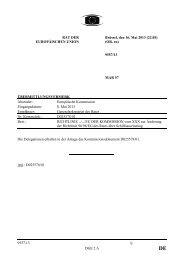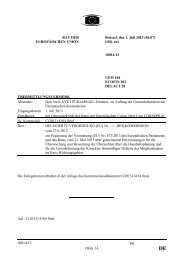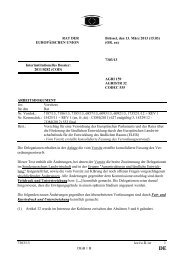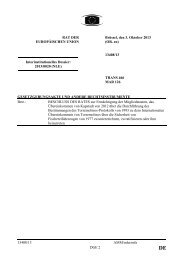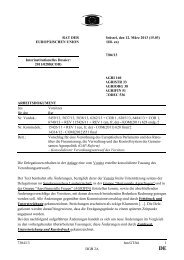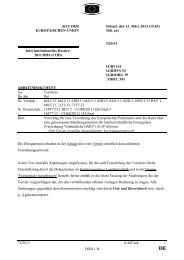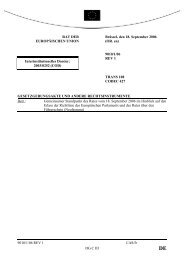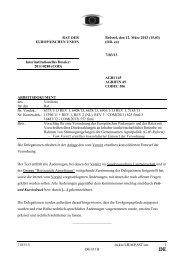EU Concept for Force Generation - the ESDC
EU Concept for Force Generation - the ESDC
EU Concept for Force Generation - the ESDC
Create successful ePaper yourself
Turn your PDF publications into a flip-book with our unique Google optimized e-Paper software.
COUNCIL OF<br />
THE <strong>EU</strong>ROPEAN UNION<br />
NOTE<br />
from : European Union Military Staff<br />
to : European Union Military Committee<br />
No. prev. doc. : <strong>EU</strong>MC Mtg Doc 25/08<br />
Subject : <strong>EU</strong> <strong>Concept</strong> <strong>for</strong> <strong>Force</strong> <strong>Generation</strong><br />
Brussels, 16 June 2008<br />
10690/08<br />
COSDP 541<br />
Delegations will find attached <strong>the</strong> <strong>EU</strong> <strong>Concept</strong> <strong>for</strong> <strong>Force</strong> <strong>Generation</strong> which was agreed by <strong>the</strong><br />
<strong>EU</strong>MC on 9 June 2008. This document supersedes <strong>the</strong> General Principles and Procedures <strong>for</strong> <strong>EU</strong><br />
<strong>Force</strong> Identification, <strong>Generation</strong>/Activation and Deployment (doc. 12398/02, dated 26 September<br />
2002).<br />
__________________<br />
10690/08 ALT/rm 1<br />
<strong>EU</strong>MS EN
<strong>EU</strong>ROPEAN UNION CONCEPT FOR<br />
FORCE GENERATION<br />
10690/08 ALT/rm 2<br />
<strong>EU</strong>MS EN
<strong>EU</strong> CONCEPT FOR<br />
FORCE GENERATION<br />
TABLE OF CONTENTS<br />
Section Page<br />
REFERENCES:............................................................................................................................................................. 4<br />
A. INTRODUCTION ............................................................................................................................................ 5<br />
B. AIM....................................................................................................................................................................... 5<br />
C. SCOPE ................................................................................................................................................................. 5<br />
D. DEFINITIONS................................................................................................................................................... 6<br />
E. PRINCIPLES ..................................................................................................................................................... 6<br />
F. FORCE GENERATION PROCESS ........................................................................................................... 7<br />
ANNEX A FORCE GENERATION PROCESS .............................................................................................. 12<br />
ANNEX B PROVISIONAL STATEMENT OF REQUIREMENTS ......................................................... 13<br />
10690/08 ALT/rm 3<br />
<strong>EU</strong>MS EN
REFERENCES:<br />
A. Suggestions <strong>for</strong> procedures <strong>for</strong> coherent, comprehensive <strong>EU</strong> crisis management<br />
(doc. 11127/03, dated 3 July 2003).<br />
B. <strong>EU</strong> <strong>Concept</strong> <strong>for</strong> Military Planning at <strong>the</strong> Political and Strategic level (doc. 10687/08, dated<br />
16 June 2008).<br />
C. <strong>EU</strong> Military Rapid Response <strong>Concept</strong> (doc. 5641/1/03 REV 1, dated 16 September 2003).<br />
D. <strong>EU</strong> Maritime Rapid Response <strong>Concept</strong> (doc. 15294/07, dated 15 November 2007).<br />
E. <strong>EU</strong> Air Rapid Response <strong>Concept</strong> (doc.16838/07, dated 21 December 2007).<br />
F. <strong>EU</strong> Battlegroups <strong>Concept</strong> (doc. 13618/06, dated 5 October 2006).<br />
G. <strong>EU</strong> Strategic M&T <strong>Concept</strong> (doc. 6457/06, dated 16 February 2006).<br />
H. Reception, Staging, Onward Movement and Integration <strong>Concept</strong><br />
(doc. 13020/06, dated 20 September 2006).<br />
I. <strong>EU</strong> <strong>Concept</strong> <strong>for</strong> Military Command and Control (doc. 10688/08, dated 16 June 2008).<br />
10690/08 ALT/rm 4<br />
<strong>EU</strong>MS EN
A. INTRODUCTION<br />
1. Member States (MS) political commitment, which later translates into appropriate military<br />
assets and/or capabilities offered, constitutes a key <strong>for</strong> <strong>the</strong> success of an operation. Without<br />
significant offers from MS, <strong>the</strong> <strong>Force</strong> <strong>Generation</strong> (FG) process cannot be accomplished and<br />
an <strong>EU</strong>-led military operation cannot be launched. Limitations imposed by Troop Contributing<br />
Nations (TCN) on <strong>the</strong>ir offered military assets, can also endanger <strong>the</strong> launch of a planned<br />
operation and/or <strong>the</strong> success of an operation.<br />
2. This concept reflects <strong>the</strong> framework <strong>for</strong> preparing <strong>EU</strong>-led military operations as well as <strong>the</strong><br />
practical experience gained during planning of operations. It is in line with <strong>the</strong> general Crisis<br />
Management Procedures (Ref. A) and <strong>the</strong> principles of <strong>the</strong> Military Planning at <strong>the</strong> Political<br />
and Strategic level (Ref. B).<br />
3. This document should be read in conjunction with <strong>the</strong> <strong>EU</strong> <strong>Concept</strong> <strong>for</strong> Military Planning at<br />
B. AIM<br />
<strong>the</strong> Political and Strategic level and <strong>the</strong> <strong>EU</strong> <strong>Concept</strong> <strong>for</strong> Military Command and Control.<br />
4. This document sets out <strong>the</strong> principles and procedures <strong>for</strong> <strong>the</strong> generation of military <strong>for</strong>ces and<br />
capabilities <strong>for</strong> <strong>EU</strong>-led military operations.<br />
C. SCOPE<br />
5. The principles and <strong>the</strong> process described in this document apply to <strong>the</strong> full spectrum of<br />
potential <strong>EU</strong>-led military operations and have been designed to assist all relevant stakeholders<br />
to identify and activate military assets and/or capabilities required <strong>for</strong> a particular operation,<br />
from <strong>the</strong> initial considerations up to <strong>the</strong> Transfer of Authority (TOA) of <strong>the</strong> deployed <strong>for</strong>ce to<br />
<strong>the</strong> Operation Commander (OpCdr).<br />
10690/08 ALT/rm 5<br />
<strong>EU</strong>MS EN
D. DEFINITIONS<br />
6. FG is <strong>the</strong> process where <strong>the</strong> military assets and capabilities required <strong>for</strong> an <strong>EU</strong>-led military<br />
operation are designated by TCN and/or International Organisations 1 and made available to<br />
<strong>the</strong> OpCdr to meet <strong>the</strong> requirements of <strong>the</strong> operation. It comprises <strong>the</strong> identification and <strong>the</strong><br />
activation of <strong>the</strong> required assets and/or capabilities and ends with <strong>the</strong>ir TOA by TCN to <strong>the</strong><br />
OpCdr.<br />
7. TCN are those MS and, after a Council decision (Ref. A), third States providing military<br />
assets or capabilities <strong>for</strong> a particular operation.<br />
E. PRINCIPLES<br />
8. FG is integral to <strong>the</strong> planning of <strong>the</strong> operation. It should be considered at <strong>the</strong> earliest stages of<br />
<strong>the</strong> planning process. It has to be tailored to <strong>the</strong> specific requirements of each operation. A<br />
lack of precise and timely in<strong>for</strong>mation will affect adversely <strong>the</strong> MS' considerations and<br />
decisions regarding <strong>for</strong>ce contributions and <strong>the</strong> establishment of a chain of command, in<br />
particular <strong>the</strong> Operation Headquarters (OHQ) and <strong>the</strong> <strong>Force</strong> Headquarters (FHQ).<br />
9. It is <strong>the</strong> OpCdr who provides <strong>the</strong> necessary level of detail <strong>for</strong> FG through <strong>the</strong> production of<br />
<strong>the</strong> <strong>Concept</strong> of Operations (CONOPS) and <strong>the</strong> Operation Plan (OPLAN) in a later stage of <strong>the</strong><br />
planning process (Ref. A). However, to assist TCN deliberations on <strong>for</strong>ce contributions <strong>the</strong><br />
<strong>EU</strong>MS should produce an initial estimate of <strong>the</strong> generic capability requirement.<br />
1 The Berlin + arrangements set <strong>the</strong> conditions <strong>for</strong> <strong>the</strong> release, monitoring and return or recall<br />
of NATO assets and capabilities <strong>for</strong> <strong>the</strong>ir use in an <strong>EU</strong>-led military operation.<br />
10690/08 ALT/rm 6<br />
<strong>EU</strong>MS EN
10. MS' commitments of assets and capabilities are <strong>the</strong> basis of <strong>the</strong> whole FG process. Ideally, <strong>the</strong><br />
<strong>for</strong>ces <strong>for</strong> an operation should be committed without caveats. Never<strong>the</strong>less, MS are ultimately<br />
responsible <strong>for</strong> <strong>the</strong> conditions upon which <strong>the</strong>ir committed <strong>for</strong>ces are made available to <strong>the</strong><br />
<strong>EU</strong>. Caveats should be stated by TCN as early as possible to allow timely modifications of <strong>the</strong><br />
Statement of Requirements (SOR), and as a consequence to adjust operational planning<br />
accordingly.<br />
11. The <strong>EU</strong> can invite third States to contribute to an <strong>EU</strong>-led military operation. When a third<br />
State participates, <strong>the</strong> principles and guidelines described in this document will apply.<br />
12. The <strong>for</strong>ce must be tailored to satisfy <strong>the</strong> specific requirements of <strong>the</strong> operation. It is highly<br />
likely that <strong>the</strong>re will be potentially different capability requirements in terms of response,<br />
readiness and <strong>for</strong>ce size <strong>for</strong> each <strong>EU</strong>-led military operation. Reserve <strong>for</strong>ce requirements at all<br />
levels of command should be addressed at <strong>the</strong> earliest possible stage of <strong>the</strong> FG process.<br />
13. When a rapid response is required, <strong>the</strong> quick designation of <strong>the</strong> OpCdr and <strong>the</strong> FCdr, <strong>the</strong><br />
simultaneous activation of <strong>the</strong> OHQ and <strong>the</strong> FHQ, as well as <strong>the</strong> identification of possible<br />
capability packages and command and control structures will facilitate an accelerated FG<br />
process (Ref. C). The mechanisms described in <strong>the</strong> Maritime and Air Rapid Response<br />
concepts (Ref D and E) will facilitate <strong>the</strong> identification of potential capabilities without<br />
creating additional ''standing <strong>for</strong>ces''. <strong>EU</strong> Battlegroups on standby could benefit from <strong>the</strong><br />
mentioned mechanisms <strong>for</strong> <strong>the</strong> identification of relevant assets and required capabilities <strong>for</strong> a<br />
particular operation (Ref. F).<br />
F. FORCE GENERATION PROCESS<br />
14. FG <strong>for</strong> <strong>the</strong> build up of an <strong>EU</strong>-led <strong>for</strong>ce includes <strong>the</strong> identification of <strong>the</strong> appropriate assets and<br />
capabilities and <strong>the</strong> commitment of TCN to pledge and activate <strong>the</strong>m. It also includes <strong>the</strong><br />
subsequent assembly and deployment to <strong>the</strong> designated JOA by TCN, coordinated by <strong>the</strong><br />
OHQ/FHQ (Annex A). The process can be divided into three different phases: identification,<br />
activation and deployment.<br />
10690/08 ALT/rm 7<br />
<strong>EU</strong>MS EN
15. The OpCdr, once designated by <strong>the</strong> Council, is responsible <strong>for</strong> <strong>the</strong> FG process, which is<br />
directly related to <strong>the</strong> development of <strong>the</strong> CONOPS and <strong>the</strong> OPLAN. An early designation of<br />
<strong>the</strong> OpCdr and <strong>the</strong> OHQ will allow timely publication of <strong>the</strong> SOR and a quicker initiation of<br />
<strong>the</strong> FG process.<br />
16. TCN are responsible <strong>for</strong> <strong>the</strong> activation and <strong>the</strong> deployment (Ref. G) of <strong>the</strong>ir committed <strong>for</strong>ces<br />
and/or capabilities.<br />
<strong>Force</strong> Identification Phase:<br />
17. This phase identifies <strong>the</strong> set of capabilities and <strong>for</strong>ces required to undertake <strong>the</strong> military tasks<br />
derived from <strong>the</strong> mission. Early identification of such requirements will allow fur<strong>the</strong>r<br />
planning to be conducted and allow potential TCN to identify <strong>the</strong>ir possible contributions as<br />
well as likely financial consequences.<br />
18. During <strong>the</strong> preparation of <strong>the</strong> Crisis Management <strong>Concept</strong> (CMC) 2 indicative contribution<br />
meetings could be conducted by <strong>the</strong> <strong>EU</strong>MS to provide MS with an early indication of <strong>the</strong><br />
expected capability requirements, based on military assessment and analysis, and ga<strong>the</strong>r<br />
indications from MS on possible contributions, in particular <strong>the</strong> OHQ. Commitments made at<br />
indicative contribution meetings are not binding. An assessment of <strong>the</strong> indicative<br />
contributions should be part of <strong>the</strong> Military Advice on <strong>the</strong> CMC.<br />
19. The development of <strong>the</strong> Military Strategic Options (MSOs) should include an estimated<br />
capability requirement and an indication of <strong>for</strong>ces that might be made available by potential<br />
TCN. There<strong>for</strong>e, MS should provide <strong>the</strong> <strong>EU</strong>MS with indications of <strong>the</strong>ir intention to<br />
contribute to <strong>the</strong> operation, be<strong>for</strong>e <strong>the</strong> Council selects a MSO.<br />
20. Consultations with potential non-<strong>EU</strong> TCN may take place at this point to ensure that <strong>the</strong>y are<br />
2<br />
in<strong>for</strong>med of <strong>the</strong> <strong>EU</strong>'s intentions.<br />
Reference A, paragraphs 29, 33 and 34.<br />
10690/08 ALT/rm 8<br />
<strong>EU</strong>MS EN
21. Any requirement <strong>for</strong> rapid response <strong>for</strong>ce elements or enabling <strong>for</strong>ce elements will necessitate<br />
early preparatory consultations with MS 3 .<br />
22. TCN should state, at <strong>the</strong> earliest stage, all caveats and o<strong>the</strong>r restrictions, such as national<br />
procedures or operational limitations that limit <strong>the</strong>ir <strong>for</strong>ces meeting <strong>the</strong> operation<br />
requirements. A significant number of limitations could result in an increase in <strong>the</strong> size of <strong>the</strong><br />
<strong>for</strong>ce required. This could complicate <strong>the</strong> planning process and delay <strong>the</strong> generation of <strong>the</strong><br />
<strong>for</strong>ce.<br />
23. <strong>EU</strong>MS preparatory work will be taken into account by <strong>the</strong> OpCdr during <strong>the</strong> development of<br />
<strong>the</strong> CONOPS. The CONOPS will <strong>for</strong>m <strong>the</strong> basis <strong>for</strong> <strong>the</strong> Provisional SOR (PSOR) (Annex B)<br />
to be elaborated by <strong>the</strong> OpCdr.<br />
<strong>Force</strong> Activation Phase:<br />
24. Following approval of <strong>the</strong> CONOPS and based on his PSOR, <strong>the</strong> OpCdr will initiate <strong>the</strong> <strong>Force</strong><br />
Activation. The OpCdr will <strong>for</strong>ward <strong>the</strong> <strong>EU</strong> Activation Warning message (<strong>EU</strong> ACTWARN) 4<br />
and <strong>the</strong> PSOR to all TCN 5 . The activation process should start as early as possible and could<br />
be conducted simultaneously with <strong>the</strong> final steps of <strong>the</strong> <strong>for</strong>ce identification phase. Any<br />
additional in<strong>for</strong>mation on national caveats should be sent to <strong>the</strong> OpCdr as soon as possible.<br />
25. The <strong>EU</strong> ACTWARN <strong>for</strong>mally in<strong>for</strong>ms <strong>the</strong> addressees that a <strong>for</strong>ce will be required, outlines<br />
<strong>the</strong> potential operation, including <strong>the</strong> military mission, and provides key planning dates, in<br />
particular <strong>for</strong> <strong>the</strong> FG Conference(s). The PSOR provides TCN with an indication of <strong>the</strong> type<br />
and scale of <strong>for</strong>ces, assets and capabilities required. Addressees should respond to <strong>the</strong> <strong>EU</strong><br />
ACTWARN with in<strong>for</strong>mal offers including <strong>the</strong>ir intention to take a leading role in any area.<br />
3 Considerations on early deployment should include, but not be limited to, ISTAR, CIMIC and<br />
PsyOps units.<br />
4 <strong>EU</strong> OHQ SOP (doc. 15718/06, dated 22 December 2006), Procedure 05310 in Section 5.<br />
5 Reference A, paragraph 58.<br />
10690/08 ALT/rm 9<br />
<strong>EU</strong>MS EN
26. In<strong>for</strong>mal offers should be assessed by <strong>the</strong> OpCdr as to <strong>the</strong> suitability of those <strong>for</strong>ces and<br />
capabilities to participate in <strong>the</strong> operation. Based on <strong>the</strong> in<strong>for</strong>mal <strong>for</strong>ce offers, FG conferences<br />
will confirm <strong>the</strong> level and specifics of TCN contributions. These conferences are conducted<br />
by <strong>the</strong> OpCdr, with <strong>the</strong> assistance of <strong>the</strong> <strong>EU</strong>MS (Ref. A) 6 .<br />
27. Once <strong>the</strong> in<strong>for</strong>mal offers meet <strong>the</strong> requirements, <strong>the</strong> OpCdr will develop <strong>the</strong> Draft SOR<br />
reflecting TCN offered contributions 7 . It details <strong>the</strong> proposed <strong>for</strong>ce package <strong>for</strong> <strong>the</strong> operation.<br />
The OPLAN and <strong>the</strong> SOR will be developed coherently in an iterative process. If in<strong>for</strong>mal<br />
offers do not meet <strong>the</strong> requirements, <strong>the</strong> OpCdr will report to <strong>the</strong> PSC through <strong>the</strong> C<strong>EU</strong>MC as<br />
his primary point of contact.<br />
28. Once <strong>the</strong> Draft SOR has been developed, <strong>the</strong> OpCdr will issue <strong>the</strong> <strong>EU</strong> Activation Request<br />
Message (<strong>EU</strong> ACTREQ) requesting TCN to <strong>for</strong>mally commit to <strong>the</strong> <strong>for</strong>ce package detailed in<br />
<strong>the</strong> Draft SOR 8 . TCN will reply with <strong>the</strong> <strong>for</strong>mal commitment of contributions through <strong>the</strong> <strong>EU</strong><br />
<strong>Force</strong> Preparation Message (<strong>EU</strong> FORCEPREP) 9 . This message may include caveats<br />
(geographical, logistic, time-related, rules of engagement, etc.) that govern <strong>the</strong> employment of<br />
committed <strong>for</strong>ces.<br />
29. Following <strong>the</strong> receipt of all <strong>EU</strong> FORCEPREP messages, <strong>the</strong> OpCdr may conduct one or a<br />
series of <strong>Force</strong> Balancing Conferences to address any shortfall or surplus commitment. Once<br />
<strong>the</strong> SOR is met through <strong>the</strong> <strong>Force</strong> <strong>Generation</strong> and Balancing Conferences and if <strong>the</strong> OpCdr<br />
assesses that any remaining shortfalls are not critical to mission execution, he releases <strong>the</strong> <strong>EU</strong><br />
<strong>Force</strong> List. It confirms <strong>the</strong> TCN commitments to <strong>the</strong> <strong>EU</strong>-led <strong>for</strong>ce. Should <strong>the</strong> OpCdr assess<br />
that he is unable to fulfil <strong>the</strong> mission with <strong>the</strong> <strong>for</strong>ces committed he will report to <strong>the</strong> PSC<br />
through <strong>the</strong> C<strong>EU</strong>MC as his primary point of contact (Ref. I).<br />
6 Reference A, paragraphs 66 and 67.<br />
7 <strong>EU</strong> OHQ SOP (doc. 15718/06, dated 22 December 2006), Procedure 05360 in Section 5.<br />
8 <strong>EU</strong> OHQ SOP (doc. 15718/06, dated 22 December 2006), Procedure 05320 in Section 5.<br />
9 <strong>EU</strong> OHQ SOP (doc. 15718/06, dated 22 December 2006), Procedure 05330 in Section 5.<br />
10690/08 ALT/rm 10<br />
<strong>EU</strong>MS EN
30. The <strong>EU</strong> <strong>Force</strong> List will be included in <strong>the</strong> OPLAN. This completes <strong>the</strong> <strong>Force</strong> Activation<br />
phase. Approval of <strong>the</strong> OPLAN by <strong>the</strong> Council will authorise <strong>the</strong> OpCdr to issue <strong>the</strong> <strong>EU</strong><br />
Activation Order (<strong>EU</strong> ACTORD) 10 .<br />
31. Given <strong>the</strong> important role of <strong>the</strong> OHQ during this phase, its activation and build up process, in<br />
particular incorporating primary augmentees from MS, is a priority. To allow proper planning<br />
and <strong>the</strong> coordination of <strong>the</strong> deployment, a simultaneous build up of OHQ and FHQ is<br />
desirable. Depending on <strong>the</strong> mission, it could be necessary to create new positions within <strong>the</strong><br />
OHQ that will have to be filled by additional personnel from TCN through <strong>the</strong> appropriate<br />
manning conferences.<br />
<strong>Force</strong> Deployment Phase:<br />
32. Initiated by <strong>the</strong> Activation Order, this phase includes <strong>the</strong> assembly, deployment and <strong>the</strong> TOA<br />
of <strong>the</strong> <strong>for</strong>ces to <strong>the</strong> OpCdr. This phase of <strong>the</strong> FG process is <strong>the</strong> responsibility of TCN.<br />
References G and H provide guidance on movement and transportation of <strong>the</strong> <strong>for</strong>ce, under <strong>the</strong><br />
co-ordination of <strong>the</strong> OHQ and FHQ. TCN authorise TOA of <strong>the</strong>ir respective <strong>for</strong>ces to <strong>the</strong><br />
OpCdr as soon as possible after <strong>the</strong>ir arrival in <strong>the</strong> JOA. The TOA of <strong>the</strong> <strong>for</strong>ces to <strong>the</strong> OpCdr<br />
constitutes <strong>the</strong> final step of <strong>the</strong> FG process.<br />
________________________<br />
10 <strong>EU</strong> OHQ SOP (doc. 15718/06, dated 22 December 2006), Procedure 05350 in Section 5.<br />
10690/08 ALT/rm 11<br />
<strong>EU</strong>MS EN
FORCE GENERATION PROCESS<br />
CRISIS MANAGEMENT PROCEDURES AND MILITARY PLANNING FORCE GENERATION<br />
Council/PSC<br />
Phase 1: Routine Advance Mil Planning<br />
Phase 2: Crisis build-up<br />
CMC<br />
Phase 3: CMC approval<br />
Phase 4: Formal decision to take action<br />
Selection of MSO<br />
(Joint Action)<br />
IMD<br />
CONOPS<br />
OPLAN<br />
Phase 5: Implementation<br />
<strong>EU</strong>MC<br />
Mil Adv. on CMC<br />
MSOD<br />
Mil Adv. On MSOs<br />
Mil Adv. On IMD<br />
Mil Adv. On CONOPS<br />
Upon PSC request,<br />
tasks OpCdr to<br />
conduct FG<br />
<strong>EU</strong>MS<br />
Draft Mil Adv. on CMC<br />
MSOs<br />
IMD Guidance C2 Chain<br />
Draft IMD<br />
OpCdr Council/PSC<br />
<strong>EU</strong>MS<br />
OpCdr<br />
TCN<br />
Draft CONOPS<br />
(+PSOR)<br />
Draft OPLAN<br />
<strong>Force</strong> Identification<br />
<strong>Force</strong> Activation<br />
Decision to launch <strong>the</strong><br />
Operation<br />
<strong>Force</strong> Deployment<br />
Indicative Contribution<br />
Meetings<br />
Compilation of<br />
indicative<br />
commitments<br />
ANNEX A<br />
10690/08 ALT/rm 12<br />
Annex A <strong>EU</strong>MS EN<br />
Info<br />
Provisional SOR<br />
ACTWARN<br />
FG Conferences<br />
Draft SOR<br />
ACTREQ<br />
<strong>Force</strong> Balancing<br />
Conferences<br />
<strong>Force</strong> List<br />
ACTORD<br />
TOA<br />
Info<br />
Preliminary indication<br />
of intention to<br />
contribute<br />
Info<br />
In<strong>for</strong>mal Offers<br />
FORCEPREP<br />
Deployment
SERIAL FORCE ELEMENT<br />
ANNEX B<br />
PROVISIONAL STATEMENT OF REQUIREMENTS<br />
PSOR DATE<br />
SPECIFIC<br />
CAPABILITIES<br />
LOCATION<br />
HIGHER<br />
COMMAND<br />
TYPE OF<br />
UNIT<br />
REQUIRED<br />
UNIT SIZE<br />
UNIT<br />
STRENGTH<br />
10690/08 ALT/rm 13<br />
Annex B <strong>EU</strong>MS EN<br />
ADVANCE<br />
FORCES<br />
MAIN<br />
BODY<br />
TOTAL<br />
STRENGTH<br />
TCN<br />
OFFERS<br />
DURATION REMARKS<br />
In<strong>for</strong>mation on <strong>for</strong>ce elements should be as complete and detailed as possible.<br />
Any limitation <strong>for</strong> <strong>the</strong> employment of <strong>the</strong> <strong>for</strong>ce elements should be clearly stated in <strong>the</strong> remarks.<br />
The columns shown in <strong>the</strong> table above are <strong>the</strong> minimum required in<strong>for</strong>mation. Additional columns could be included as appropriate.<br />
The in<strong>for</strong>mation of <strong>the</strong> PSOR will constitute <strong>the</strong> basis <strong>for</strong> <strong>the</strong> development of <strong>the</strong> much more detailed draft SOR and SOR by <strong>the</strong> OpCdr




